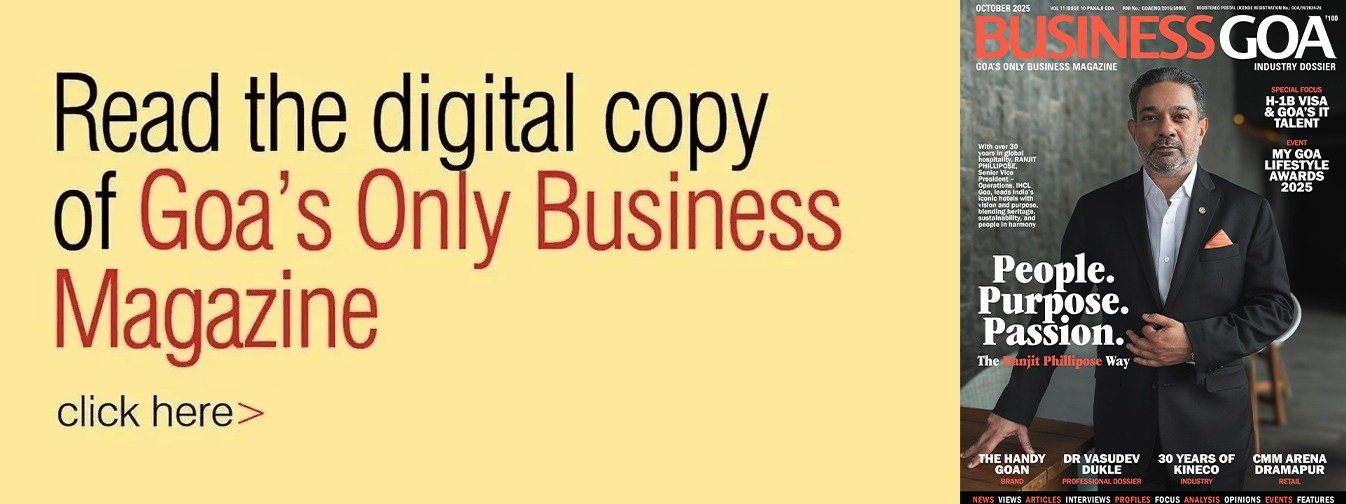
From policy reforms to public-private partnerships, Goa charts a transformative path to reposition tourism as a cornerstone of inclusive growth and global appeal
The tourism industry remains a significant contributor to Goa’s state revenue, second only to mining. Renowned for its pristine beaches and warm hospitality, Goa traditionally experiences its peak tourist season between November and February. However, the current season has witnessed a marked decline, attributed to factors such as overpricing, negative portrayals by social media influencers, and a reduction in the number of foreign tourists.
We examine the key challenges currently confronting the tourism sector and explore various policies, initiatives, and schemes being introduced by the state government to revitalise and support an industry that finds itself in a critical state.
Voices of Shack Owners
Cruz Cardozo, President of the Goa Shack Owners Welfare Society (SOWS), described the current tourism season as “not too good, but not too bad” – falling somewhere between expectations.
Cardozo noted that, unlike the previous year, licences were issued earlier this season, allowing shacks to be set up on time. Nevertheless, several factors have hindered the sector from operating at full capacity. The SOWS has already raised multiple concerns, including the lack of toilet facilities on beaches, insufficient changing rooms, the threat posed by stray dogs, inadequate lighting in certain areas, and a new proposal for a joint sewage collection and disposal system via a common pipeline – a project that would require implementation by the relevant authorities. Cardozo also stressed the importance of unified action among all stakeholders within the tourism industry to tackle the ongoing issues collectively.
Rising fixed costs have compelled some shack owners to shut down operations, while others are barely managing to stay afloat. However, Cardozo confirmed that many shacks experienced a relatively successful period of approximately two and a half months, from December to late February. A particular concern expressed by shack owners in South Goa is the decline in tourist footfall, attributed to the shift of international flight operations from Dabolim Airport to the Mopa Airport.
Shack owners also voiced serious concerns over negative portrayals of Goa on social media by certain influencers. They alleged that some of this content constitutes targeted campaigns rather than genuine reviews, and called for appropriate action to be taken against individuals deliberately damaging the state’s image. They emphasised that repeat visitors often have a strong emotional connection with Goa and could serve as authentic ambassadors by sharing their positive experiences and relationships with local communities.
In efforts to diversify the state’s tourism appeal, the stakeholders proposed the promotion of hinterland tourism, which would offer visitors a deeper cultural experience. They also highlighted the need to re-engage with the international tourist market to restore and boost foreign tourist inflow.
These perspectives provide valuable insight into the current challenges faced by Goa’s tourism industry and underline the urgency of coordinated and strategic intervention to ensure its revival and long-term sustainability.
Potential risks to the tourism industry from overpricing
Transport Minister Mauvin Godinho has urged stakeholders to address the pressing issue of overpricing, warning of its potential long-term repercussions on Goa’s tourism industry. He highlighted that excessive pricing by airlines, taxi operators, and restaurants could significantly harm the state’s reputation as a tourist destination.
Minister Godinho also criticised a prevailing mindset among some service providers in Goa, wherein the state’s popularity is exploited to charge inflated prices without due consideration for sustainability or visitor satisfaction. He cautioned that such practices, if left unchecked, could pose a serious threat to the future of tourism in the region.
In addition, he underscored the initiatives undertaken by the government to revitalise the sector, including the integration of hinterland tourism into Goa’s broader tourism strategy. He stressed the importance of active local participation in these efforts to ensure inclusive and sustainable growth of the industry.
Establishment of a Project Management Unit for strategic tourism development
The Department of Tourism is set to appoint a Project Management Unit (PMU) for a five-year term to provide dedicated project management support for various tourism initiatives undertaken by the Goa Tourism Board (GTB).
The PMU will play a pivotal role in the effective planning and implementation of the Goa Tourism Master Plan (GTMP), while also offering strategic consultation in the areas of investment promotion and policy formulation. A core responsibility of the PMU will be to conduct feasibility studies to identify and recommend new schemes for the GTB, advise on the formulation of policies, and ensure alignment with sustainable development principles.
Additionally, the PMU will support the identification of potential funding bodies, including the Central Government, the World Bank, and other multilateral or bilateral agencies, which could serve as key drivers for upcoming tourism projects in the state. The unit will also be instrumental in the development of Key Performance Indicators (KPIs) and the establishment of a robust monitoring and evaluation framework. This framework will be used to periodically assess the performance of Goa’s tourism sector in comparison with national and international destinations, identify challenges faced by tourists, and evaluate the impact of implemented projects. Based on these evaluations, the PMU will recommend priority areas for improvement.
Moreover, the PMU will assist the GTB in developing regulatory guidelines for existing tourism operators, preparing sector-specific profiles, investor pitch presentations, and promotional material for lesser-explored tourism segments in the state, with the aim of attracting new investment.
To encourage private sector participation, the PMU will facilitate capacity-building initiatives for tourism stakeholders, support the formulation of investor-friendly policies, and coordinate with the Goa Investment Promotion and Facilitation Board to boost private sector engagement in tourism development.
The PMU will also support the GTB in preparing short-, medium-, and long-term strategies, as well as in drafting a comprehensive blueprint for tourism infrastructure development, including opportunities for private sector investment and participation.
Redevelopment of Britona property through Public-Private Partnership
In light of the deteriorated condition of the Britona property, which has remained in a dilapidated state for over a decade, the Goa Tourism Development Corporation (GTDC) has proposed its redevelopment through private sector investment. The project will be undertaken on a Design, Build, Finance, Operate, and Transfer (DBFOT) basis, encompassing the redevelopment, operation, and long-term maintenance of the property.
The concession agreement will span a period of 30 years, with the option of an extension for a further 30 years at the discretion of the GTDC. Under the agreement, the selected private entity will be authorised to develop, operate, and maintain a city hotel of three-star category or higher, with a minimum of 15 rooms, along with a multi-cuisine restaurant and other necessary amenities.
As part of its operational obligations, the private operator will be required to ensure that at least 80% of the workforce employed at the facility comprises individuals holding Goan domicile, thereby enhancing employment opportunities for the local population.
Subject to feasibility studies and prevailing market conditions, the developer may also explore the inclusion of additional permissible facilities within the project premises. These may include, but are not limited to, a fitness studio, swimming pool or pool lounge, beauty salon, and spa.
The site plan, as referenced by the GTDC, clearly delineates the 100/50-metre High Tide Line in accordance with the Coastal Zone Management Plan (CZMP) 2011, due to the property’s proximity to the River Mandovi and the presence of mangroves along its banks.
Through the issuance of a public tender, the GTDC has invited EoI from potential investors for the redevelopment, operation, and upkeep of the property. The tender document seeks bidders to consider utilising the existing structure where feasible, as part of their redevelopment proposals.





